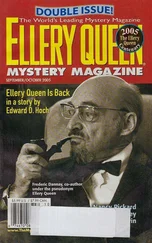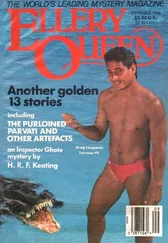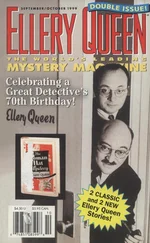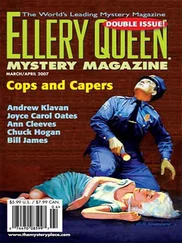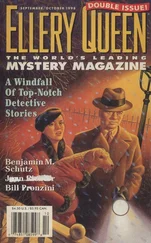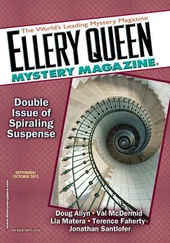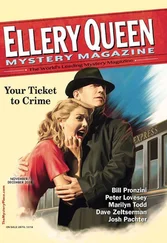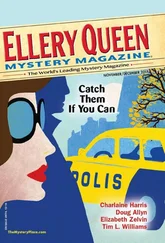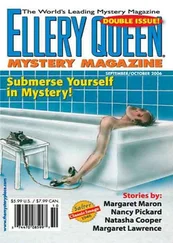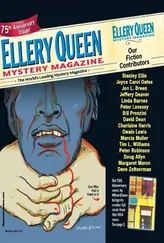William Bankier - Ellery Queen’s Mystery Magazine, Vol. 110, No. 3 & 4. Whole No. 673 & 674, September/October 1997
Здесь есть возможность читать онлайн «William Bankier - Ellery Queen’s Mystery Magazine, Vol. 110, No. 3 & 4. Whole No. 673 & 674, September/October 1997» весь текст электронной книги совершенно бесплатно (целиком полную версию без сокращений). В некоторых случаях можно слушать аудио, скачать через торрент в формате fb2 и присутствует краткое содержание. Город: New York, Год выпуска: 1997, Издательство: Dell Magazines, Жанр: Детектив, на английском языке. Описание произведения, (предисловие) а так же отзывы посетителей доступны на портале библиотеки ЛибКат.
- Название:Ellery Queen’s Mystery Magazine, Vol. 110, No. 3 & 4. Whole No. 673 & 674, September/October 1997
- Автор:
- Издательство:Dell Magazines
- Жанр:
- Год:1997
- Город:New York
- ISBN:нет данных
- Рейтинг книги:4 / 5. Голосов: 1
-
Избранное:Добавить в избранное
- Отзывы:
-
Ваша оценка:
- 80
- 1
- 2
- 3
- 4
- 5
Ellery Queen’s Mystery Magazine, Vol. 110, No. 3 & 4. Whole No. 673 & 674, September/October 1997: краткое содержание, описание и аннотация
Предлагаем к чтению аннотацию, описание, краткое содержание или предисловие (зависит от того, что написал сам автор книги «Ellery Queen’s Mystery Magazine, Vol. 110, No. 3 & 4. Whole No. 673 & 674, September/October 1997»). Если вы не нашли необходимую информацию о книге — напишите в комментариях, мы постараемся отыскать её.
Ellery Queen’s Mystery Magazine, Vol. 110, No. 3 & 4. Whole No. 673 & 674, September/October 1997 — читать онлайн бесплатно полную книгу (весь текст) целиком
Ниже представлен текст книги, разбитый по страницам. Система сохранения места последней прочитанной страницы, позволяет с удобством читать онлайн бесплатно книгу «Ellery Queen’s Mystery Magazine, Vol. 110, No. 3 & 4. Whole No. 673 & 674, September/October 1997», без необходимости каждый раз заново искать на чём Вы остановились. Поставьте закладку, и сможете в любой момент перейти на страницу, на которой закончили чтение.
Интервал:
Закладка:
“Then you got spooked. The woman came to and started to scream. You finished things up with the hammer and started to run out the door. The husband saw you in the doorway with the bloody hammer and the stereo and their CD collection under your arm. He called the cops and they nailed you. A fair representation of events?”
“Wasn’t all their CDs. I didn’t take the Michael Bolton.”
“Don’t ever try to be funny with me.”
Pilsett flicked his earlobe again. “Was pretty much what happened.”
“All right, Jerry. Listen. This’s a small town and people here’re plenty stupid. I consider myself the best defense lawyer in the country but this case is open and shut. You did it, everyone knows you did it, and the evidence is completely against you. They don’t have the death penalty in this state but they’re damn generous when it comes to handing out life terms with no chance for parole. So. That’s the future you’re facing.”
“Yup. And know what it tells me? Tells me you’re the one can’t lose on this here situation.” Pilsett grinned.
Maybe they weren’t as dumb in Hamilton as he thought.
The young man continued, “You come all the way here from New York. You do the trial and you leave. If you get me off, you’re a celebrity and you get paid and on Geraldo or Oprah or some such for winning a hopeless case. And if you lose, you get paid and nobody gives a damn because I got put away like I oughta.”
Lescroix had to grin. “Jerry, Jerry, Jerry. That’s one thing I just love about this line of work. No charades between us.”
“What’s charades?”
“Come on, you gonna hire me and boot that Goodwin back to the law library, where he belongs?”
He flicked his earlobe again. The chains clinked. “Guess I will.”
“Then let’s get to work.”
Paul Lescroix’s resume had been amply massaged over the years. He’d gone to a city law school at night. Which wouldn’t of course play in the many news stories he fantasized would feature him, so after he graduated he signed up fast for continuing ed courses in Cambridge, which were open to any lawyer willing to pay five hundred bucks. Accordingly the claim that he was “Harvard educated” was true.
He got a job at minimum wage transcribing and filing judicial opinions for traffic court magistrates. So he could say that he’d served his apprenticeship clerking and writing opinions for criminal court judges.
He opened a solo practice above Great Eastern Cantonese carryout in a sooty building off Maiden Lane in downtown Manhattan. Hence, he became “a partner in a Wall Street firm, specializing in white-collar crime.”
But these little hiccups in the history of Paul Lescroix (all right, originally Paul Vito Lacosta), these little glitches didn’t detract from his one gift — the uncanny ability to decimate his opponents in court. Which is one talent no lawyer can fake. He’d unearth every fact he could about the case, the parties, the judge, the prosecutor, then he’d squeeze them hard, pinch them, mold them like Play-Doh. They were facts still, but facts mutated; in his hands they became weapons, shields, viruses, disguises.
The night before the Pilsett trial, he spent one hour emptying poor Al Goodwin of whatever insights he might have about the case, two hours meeting with reporters, and ten hours reviewing two things: the police report, and a lengthy document prepared by his own private investigator, hired three days ago when James Pilsett, Jerry’s uncle, came to him with the retainer fee.
Lescroix immediately noticed that while the circumstantial evidence against Pilsett was substantial, the biggest threat came from Charles Cabot himself. They were lucky of course that he was the only witness but unfortunate that he happened to be the husband of the woman who was killed. It’s a dangerous risk to attack the credibility of a witness who is also the victim of the crime.
But Paul Victor Lescroix, Esq., was paid four hundred dollars an hour against five-figure retainers for the very reason that he was willing — no, eager — to take risks like that.
Smiling to himself, he called room service for a large pot of coffee, and while murderer Jerry Pilsett and decent Al Goodwin and all the simple folk of Hamilton County dreamt their simple dreams, Lescroix planned for battle.
He arrived at the courtroom early, as he always did, and sat primly at the defense table as the witnesses and spectators and (yes, thank you, Lord, the press) showed up. He mugged subtly for the cameras and scoped out the prosecutor (state U grad, Lescroix had learned, top forty percent, fifteen years under his belt and numb from being mired in a dead-end career he should have left thirteen years ago).
Lescroix then turned his eyes to a man sitting in the back of the courtroom. Charles Cabot. He sat beside a woman in her sixties — mother or mother-in-law, Lescroix reckoned, gauging by the tears. The lawyer was slightly troubled. He’d expected Cabot to be a stiff, upper-middle-class suburbanite, someone who’d elicit little sympathy from the jury. But the man — though he was about forty — seemed boyish. He had mussed hair, dark blond, and wore a rumpled sports coat and slacks, striped tie. A friendly insurance salesman. He comforted the woman and dropped a few tears himself. He was the sort of widower a jury could easily fall in love with.
Well, Lescroix had been in worse straits. He’d had cases where he’d had to attack grieving mothers and widowed wives and even bewildered children. He’d just have to feel his way along, like a musician, sensing the audience’s reaction and adjusting his playing carefully. He could—
Lescroix realized suddenly that Cabot was staring at him. The man’s eyes were like cold ball bearings. Lescroix actually shivered — that had never before happened in court — and he struggled to maintain eye contact. It was a harrowing sixty seconds and yet Lescroix was glad for the challenge. Something in that look of Cabot’s made this whole thing personal, made it far easier to do what he was about to do. Their eyes locked, the electricity sparking between them. Then a door clicked open and everyone around them stood as the clerk entered.
“Oyez, oyez, oyez, criminal court for the county of Hamilton, First District, is now in session. The right honorable Jennings P. Martell presiding, all ye with business before this court come forward and be heard.”
Pilsett, wearing a goofy brown suit, was led cautiously out of the lockup. He sat down next to his lawyer. The defendant grinned stupidly until Lescroix told him to stop. He flicked his earlobe several times with an unshackled finger.
When Lescroix looked back to Cabot the metallic eyes had shifted from the lawyer and were drilling into the back of the man who’d killed his wife with a $4.99 Sears Craftsman claw hammer.
The prosecutor presented the forensic evidence first and Lescroix spent a half-hour chipping away at the testimony of the lab technicians and the cops — though the crime-scene work had been surprisingly well handled for such a small police department. A minor victory for the prosecution, Lescroix conceded to himself.
Then the state called Charles Cabot.
The widower straightened his tie, hugged the woman beside him, and walked to the stand.
Guided by the prosecutor’s pedestrian questions, the man gave an unemotional account of what he’d seen June third. Monosyllables of grief. A few tears. Lescroix rated the performance uncompelling, though the man’s broken words certainly held the jury’s attention. But he’d expected this; we love tragedies as much as romance and nearly as much as sex.
“No further questions, your honor,” the prosecutor said and glanced dismissively at Lescroix.
Читать дальшеИнтервал:
Закладка:
Похожие книги на «Ellery Queen’s Mystery Magazine, Vol. 110, No. 3 & 4. Whole No. 673 & 674, September/October 1997»
Представляем Вашему вниманию похожие книги на «Ellery Queen’s Mystery Magazine, Vol. 110, No. 3 & 4. Whole No. 673 & 674, September/October 1997» списком для выбора. Мы отобрали схожую по названию и смыслу литературу в надежде предоставить читателям больше вариантов отыскать новые, интересные, ещё непрочитанные произведения.
Обсуждение, отзывы о книге «Ellery Queen’s Mystery Magazine, Vol. 110, No. 3 & 4. Whole No. 673 & 674, September/October 1997» и просто собственные мнения читателей. Оставьте ваши комментарии, напишите, что Вы думаете о произведении, его смысле или главных героях. Укажите что конкретно понравилось, а что нет, и почему Вы так считаете.

